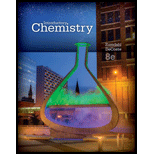
Introductory Chemistry
8th Edition
ISBN: 9781285453132
Author: Steven S. Zumdahl, Donald J. DeCoste
Publisher: Cengage Learning
expand_more
expand_more
format_list_bulleted
Concept explainers
Question
Chapter 21, Problem 11QAP
Interpretation Introduction
Interpretation:
Interpret the peptide linkage and draw structure of two dipeptides and encircling the peptide bond.
Concept Introduction:
Protein is a long chain of polypeptide in which numbers of amino acids are linked to each other to produce a structure known as protein.
Each amino acid consists of carboxyl end and amino group which are joined through peptide linkage to produce dipeptide, tripeptide and polypeptide according to number of amino acids linked to each other.
Expert Solution & Answer
Want to see the full answer?
Check out a sample textbook solution
Students have asked these similar questions
Hello, I need help with my pre-lab! We are doing a buffer solution in lab for tomorrow and were assigned 3 pH values to create. Mine were pH= 4.50 7.80 9.90
We have to perform, 1 Titration buffer, 1 solid/solution buffer, and 1 solution/solution buffer. I need help with finding out which acids to use, how much, which base to use and how much.
A chemical engineer is studying the two reactions shown in the table below.
In each case, she fills a reaction vessel with some mixture of the reactants and products at a constant temperature of 70.0 °C and constant total pressure.
Then, she measures the reaction enthalpy AH and reaction entropy AS of the first reaction, and the reaction enthalpy AH and reaction free energy AG of the
second reaction. The results of her measurements are shown in the table.
Complete the table. That is, calculate AG for the first reaction and AS for the second. (Round your answer to zero decimal places.) Then, decide whether, under
the conditions the engineer has set up, the reaction is spontaneous, the reverse reaction is spontaneous, or neither forward nor reverse reaction is spontaneous
because the system is at equilibrium.
-
P₁ (s) + 20HF (g). 4PF, (g) + 10H2(g)
AH-1005. kJ
J
AS 2929.
K
AG =
0 kJ
Which is spontaneous?
this reaction
the reverse reaction
neither
AH = 12. kJ
+0=
AS =
SnO2 (s) + 2CO(g) →…
A chemist fills a reaction vessel with 0.281 g silver chromate (Ag₂CrO4) solid, 0.710 M silver (Ag*) aqueous solution, and 0.985 M chromate (CrO2-)
aqueous solution at a temperature of 25.0°C.
Under these conditions, calculate the reaction free energy AG for the following chemical reaction:
Ag2CrO4(s) 2Ag(aq) + CrO4(aq)
Use the thermodynamic information in the ALEKS Data tab. Round your answer to the nearest kilojoule.
4
☐ kJ
x
Chapter 21 Solutions
Introductory Chemistry
Ch. 21.9 - Prob. 1CTCh. 21 - Differentiate among primary, secondary, and...Ch. 21 - Prob. 2ALQCh. 21 - Prob. 3ALQCh. 21 - Prob. 4ALQCh. 21 - Prob. 5ALQCh. 21 - Prob. 6ALQCh. 21 - Prob. 7ALQCh. 21 - Prob. 8ALQCh. 21 - Prob. 9ALQ
Ch. 21 - Prob. 10ALQCh. 21 - Prob. 11ALQCh. 21 - Prob. 1QAPCh. 21 - Prob. 2QAPCh. 21 - Prob. 3QAPCh. 21 - Prob. 4QAPCh. 21 - Prob. 5QAPCh. 21 - Prob. 6QAPCh. 21 - Prob. 7QAPCh. 21 - Prob. 8QAPCh. 21 - Prob. 9QAPCh. 21 - . How many unique amino acid sequences are...Ch. 21 - Prob. 11QAPCh. 21 - Prob. 12QAPCh. 21 - Prob. 13QAPCh. 21 - Prob. 14QAPCh. 21 - Prob. 15QAPCh. 21 - Prob. 16QAPCh. 21 - Prob. 17QAPCh. 21 - Prob. 18QAPCh. 21 - Prob. 19QAPCh. 21 - . What protein is responsible for the transport of...Ch. 21 - Prob. 21QAPCh. 21 - Prob. 22QAPCh. 21 - Prob. 23QAPCh. 21 - Prob. 24QAPCh. 21 - . How does the efficiency of an enzyme compare...Ch. 21 - Prob. 26QAPCh. 21 - Prob. 27QAPCh. 21 - . Describe the lock-and-key model for enzymes. Why...Ch. 21 - Prob. 29QAPCh. 21 - Prob. 30QAPCh. 21 - Prob. 31QAPCh. 21 - Prob. 32QAPCh. 21 - Prob. 33QAPCh. 21 - Prob. 34QAPCh. 21 - Prob. 35QAPCh. 21 - Prob. 36QAPCh. 21 - Prob. 37QAPCh. 21 - Prob. 38QAPCh. 21 - Prob. 39QAPCh. 21 - Prob. 40QAPCh. 21 - Prob. 41QAPCh. 21 - Prob. 42QAPCh. 21 - Prob. 43QAPCh. 21 - Prob. 44QAPCh. 21 - Prob. 45QAPCh. 21 - Prob. 46QAPCh. 21 - Prob. 47QAPCh. 21 - Prob. 48QAPCh. 21 - Prob. 49QAPCh. 21 - Prob. 50QAPCh. 21 - . What is a steroid? What basic ring structure 15...Ch. 21 - Prob. 52QAPCh. 21 - Prob. 53QAPCh. 21 - Prob. 54QAPCh. 21 - Prob. 55APCh. 21 - Prob. 56APCh. 21 - Prob. 57APCh. 21 - Prob. 58APCh. 21 - Prob. 59APCh. 21 - Prob. 60APCh. 21 - Prob. 61APCh. 21 - Prob. 62APCh. 21 - Prob. 63APCh. 21 - Prob. 64APCh. 21 - Prob. 65APCh. 21 - Prob. 66APCh. 21 - Prob. 67APCh. 21 - Prob. 68APCh. 21 - Prob. 69APCh. 21 - Prob. 70APCh. 21 - Prob. 71APCh. 21 - Prob. 72APCh. 21 - Prob. 73APCh. 21 - Prob. 74APCh. 21 - Prob. 75APCh. 21 - Prob. 76APCh. 21 - Prob. 77APCh. 21 - Prob. 78APCh. 21 - Prob. 79APCh. 21 - Prob. 80APCh. 21 - Prob. 81APCh. 21 - Prob. 82APCh. 21 - Prob. 83APCh. 21 - Prob. 84APCh. 21 - Prob. 85APCh. 21 - Prob. 86APCh. 21 - Prob. 87APCh. 21 - Prob. 88APCh. 21 - Prob. 89APCh. 21 - Prob. 90APCh. 21 - Prob. 91APCh. 21 - Prob. 92APCh. 21 - Prob. 93APCh. 21 - Prob. 94APCh. 21 - Prob. 95APCh. 21 - Prob. 96APCh. 21 - . How many possible primary structures exist for a...Ch. 21 - Prob. 98APCh. 21 - Prob. 99APCh. 21 - Prob. 100APCh. 21 - Prob. 101APCh. 21 - Prob. 102APCh. 21 - Prob. 103APCh. 21 - Prob. 104APCh. 21 - Prob. 105APCh. 21 - Prob. 106AP
Knowledge Booster
Learn more about
Need a deep-dive on the concept behind this application? Look no further. Learn more about this topic, chemistry and related others by exploring similar questions and additional content below.Similar questions
- Draw the structure corresponding to each IUPAC name. Part 1 of 2 A skeletal structure corresponding to the IUPAC name 3-ethylhexane. Click and drag to start drawing a structure.arrow_forwardUsing any data you can find in the ALEKS Data resource, calculate the equilibrium constant K at 25.0 °C for the following reaction. TiC₁₁(g) + 2H₂O(g) → TiO2 (s) + 4HCl (g) 4 Round your answer to 2 significant digits. K = ☐ x10 D Хarrow_forward: ☐ Х Draw an α amino acid with a hydroxyethyl (-CH2-CH2- OH) side chain. Draw the molecule as it would appear at physiological pH. Click and drag to start drawing a structure. 5 Parrow_forward
- Draw the product of the reaction shown below. Ignore inorganic byproducts. cat. H2SO4 HNO3 (1 equiv) Drawing Qarrow_forwardProvide the correct systematic name for the compound shown here.arrow_forwardUsing the appropriate bond energies, calculate the heat of reaction AH for the following reaction: H-H + CI-CI 2 H-CI You can find a table of bond energies by using the Data button on the ALEKS toolbar. Round your answer to the nearest kJ/mol. Note: For clarity, all lone pairs have been omitted from the molecular structures. ☐ kJ mol ค 000 Ar Barrow_forward
- Predict the hydrocarbon, of formula C6H10, needed to prepare the following geminal dibromide upon treatment with excess hydrobromic acid. Note: The shown product is the only regioisomer formed in this reaction. HBr H₂C. CH3arrow_forwarddraw the major product formed with the listed reagentsarrow_forwardPropose Williamson ether syntheses for the following compoundsarrow_forward
- Identify all functional groupsarrow_forwardA mixture of CaCO3 and MgC2O4 of unknown mass was heated in a 0.5 L closed rigid vessel to 900 degrees C.at 400C the following reaction occurs:MgC2O4 -> MgO (s) + CO (g) + CO2 (g)At 700C a second reaction occurs: CaCO3 -> CaO (s) + CO2 (g)The solid mass in the vessel was measured to be 3.06 g at 400C and 2.03g at 900CQuestion: What is the partial pressure of CO in both temperatures? (400 and 900C), provide detailed explanation.arrow_forwardFor the following alkyne, complete the reaction sequentially (that is draw the intermediate that we can’t stop at) and then name (complete name) all 3 molecules.arrow_forward
arrow_back_ios
SEE MORE QUESTIONS
arrow_forward_ios
Recommended textbooks for you
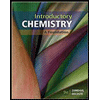 Introductory Chemistry: A FoundationChemistryISBN:9781337399425Author:Steven S. Zumdahl, Donald J. DeCostePublisher:Cengage Learning
Introductory Chemistry: A FoundationChemistryISBN:9781337399425Author:Steven S. Zumdahl, Donald J. DeCostePublisher:Cengage Learning ChemistryChemistryISBN:9781305957404Author:Steven S. Zumdahl, Susan A. Zumdahl, Donald J. DeCostePublisher:Cengage Learning
ChemistryChemistryISBN:9781305957404Author:Steven S. Zumdahl, Susan A. Zumdahl, Donald J. DeCostePublisher:Cengage Learning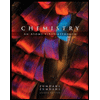 Chemistry: An Atoms First ApproachChemistryISBN:9781305079243Author:Steven S. Zumdahl, Susan A. ZumdahlPublisher:Cengage Learning
Chemistry: An Atoms First ApproachChemistryISBN:9781305079243Author:Steven S. Zumdahl, Susan A. ZumdahlPublisher:Cengage Learning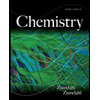
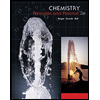 Chemistry: Principles and PracticeChemistryISBN:9780534420123Author:Daniel L. Reger, Scott R. Goode, David W. Ball, Edward MercerPublisher:Cengage Learning
Chemistry: Principles and PracticeChemistryISBN:9780534420123Author:Daniel L. Reger, Scott R. Goode, David W. Ball, Edward MercerPublisher:Cengage Learning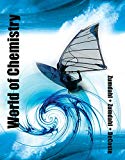 World of Chemistry, 3rd editionChemistryISBN:9781133109655Author:Steven S. Zumdahl, Susan L. Zumdahl, Donald J. DeCostePublisher:Brooks / Cole / Cengage Learning
World of Chemistry, 3rd editionChemistryISBN:9781133109655Author:Steven S. Zumdahl, Susan L. Zumdahl, Donald J. DeCostePublisher:Brooks / Cole / Cengage Learning

Introductory Chemistry: A Foundation
Chemistry
ISBN:9781337399425
Author:Steven S. Zumdahl, Donald J. DeCoste
Publisher:Cengage Learning

Chemistry
Chemistry
ISBN:9781305957404
Author:Steven S. Zumdahl, Susan A. Zumdahl, Donald J. DeCoste
Publisher:Cengage Learning

Chemistry: An Atoms First Approach
Chemistry
ISBN:9781305079243
Author:Steven S. Zumdahl, Susan A. Zumdahl
Publisher:Cengage Learning


Chemistry: Principles and Practice
Chemistry
ISBN:9780534420123
Author:Daniel L. Reger, Scott R. Goode, David W. Ball, Edward Mercer
Publisher:Cengage Learning

World of Chemistry, 3rd edition
Chemistry
ISBN:9781133109655
Author:Steven S. Zumdahl, Susan L. Zumdahl, Donald J. DeCoste
Publisher:Brooks / Cole / Cengage Learning
Biomolecules - Protein - Amino acids; Author: Tutorials Point (India) Ltd.;https://www.youtube.com/watch?v=ySNVPDHJ0ek;License: Standard YouTube License, CC-BY